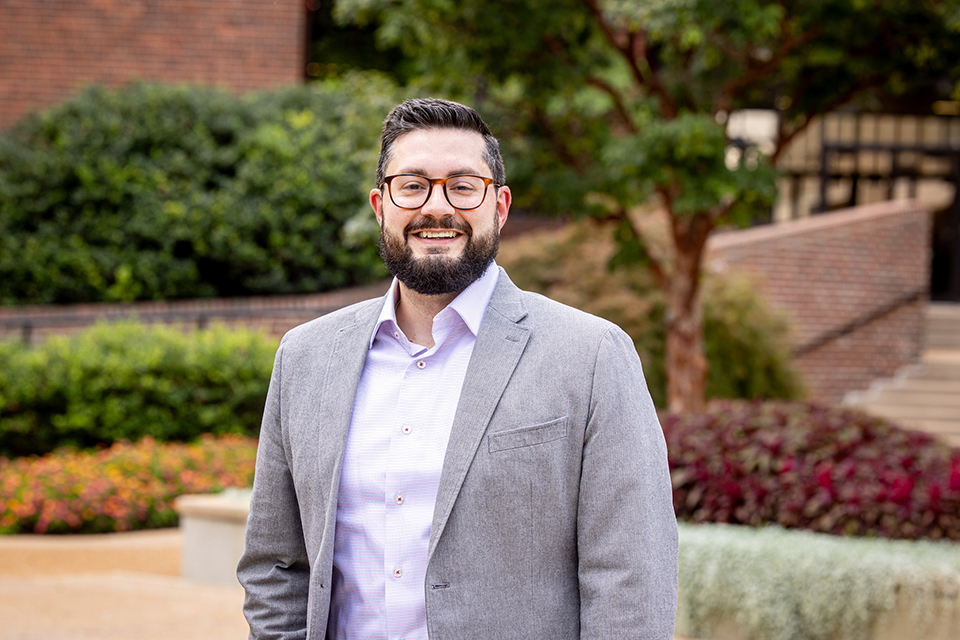SLU Primary Care Sports Physician Explains the Concussion Gender Gap
12/03/2024
ST. LOUIS — A Saint Louis University primary care sports medicine physician says there is a gender gap in research about the effects of concussions on athletes, which may be leaving women and girls without the care they need.
A concussion is a traumatic brain injury caused by a bump, blow, or jolt to the head or body. It can lead to a variety of health issues, including persistent headaches, dizziness, sleep disturbances, fatigue, changes in mood, and problems with memory or thinking. In rare cases, a head injury leads to swelling and bleeding in the brain and can even turn fatal.

Jamil Neme, M.D., associate professor in the Department of Family and Community Medicine at SLU’s School of Medicine and director of the Concussion Clinic at SSM Health Saint Louis University Hospital. Photo by Sarah Conroy.
Trauma during professional or recreational sports is a common cause of concussions in youth and adults. Research has found that the number of women and girl athletes treated for concussions has tripled in the last twenty years. However, sports concussion research has not looked much into disparities between sexes.
Jamil Neme, M.D., associate professor in the Department of Family and Community Medicine at SLU’s School of Medicine and director of the Concussion Clinic at SSM Health Saint Louis University Hospital, has closely monitored research trends. Neme said structural brain differences might explain why women and girls are more prone to concussions and experience longer recovery from injuries than men and boys.
“Take soccer, for instance; athletes have roughly the same exposure to headers; however, intrinsic factors like decreased neck muscle strength may predispose females to more concussions,” he said.
Neme added that more research is needed to determine which physiologic or biomechanical, social, and environmental factors influence injury rates between males and females. Other extrinsic factors, such as delays in care, have also been shown to influence concussion recovery.
In the dynamic and often high-impact world of sports, concussion management is an essential aspect of athlete health care. Players on the field, coaches on the sidelines, and fans in the stands should all be aware that concussion care is necessary for the safety and well-being of athletes. Sports medicine physicians – often orthopedic surgeons or non-operative physicians who are board-certified in treating people of all ages with musculoskeletal injuries or athletes' medical conditions – are pivotal in concussion management in sports.
This process begins with an initial assessment, where a doctor or athletic trainer evaluates an athlete immediately after an incident, checking for balance, coordination, and reflexes. The assessment might include a detailed neurological exam to evaluate an athlete’s sensory and motor responses. Cognitive tests are a critical component of the diagnosis. These tests assess an athlete’s memory, concentration, and ability to process information.
Neme notes that there have been advances in concussion treatment. At one time, researchers believed that removing all physical activity and mental stimulation following a concussion would give the brain time to rest and heal. More recent data shows that progressively increasing cognitive and physical activity following one or two days of relative rest accelerates recovery and gets patients back to what they love faster.
Preventing concussions will always be better than the most sophisticated recovery techniques, Neme says. Significant work has shown that reducing impacts and improving techniques during practices can reduce concussion risk. Others have identified specific training techniques that have been eliminated or altered at various levels of play.
Neme said that more work needs to be done to identify aspects of all sports that place athletes at risk and have them removed or altered to reduce injury risk.
Latest Newslink
- Helen De Cruz, Ph.D.: 1978-2025Helen De Cruz, Ph.D., the Danforth Chair in the Humanities at Saint Louis University, died Friday, June 20, 2025. She was 46. The Belgian-born philosopher examined why and how humans engage in pursuits that seem remote from the immediate concerns of survival and reproduction, such as theology, mathematics, and science.
- 'I am More Than Just a Refugee': A SLU Student Shares His StoryThe Saint Louis University-Jesuit Worldwide Learning (SLU-JWL) program offers remote bachelor's degrees to international students displaced by conflict, lack of opportunity, and poverty in places such as refugee camps in Kenya and Malawi. One student, Dictor Olame, reflected on his experience as a SLU student in the Kakuma refugee camp in North-Western Kenya.
- SLU Supports St. Louis by Hosting City's Tornado Relief CenterIn the weeks following a devastating tornado that tore through St. Louis on May 16, hundreds of households have turned to a centralized Disaster Assistance Center (DAC) at Chaifetz Arena for assistance.
- Persistence Pays Off for Fulbright Award RecipientAnuj Gandhi is a Fulbright Scholar. A year after being chosen as an alternate, Gandhi has been chosen for a Fulbright-Nehru Student Research Award. With the Award, the recent Saint Louis University graduate intends to "investigate how globalization-based acculturation influences Indian young adults' attitudes toward mental health and treatment options."
- Pestellos Honored With Honorary Street NameA stretch of Laclede Avenue that has undergone major development since President Fred P. Pestello, Ph.D., and First Lady Fran Pestello, Ph.D., arrived at Saint Louis University 11 years ago now has a new name.
- Disaster Assistance Center Opens to the Community in Response to the May 16 TornadoThe City of St. Louis, in partnership with the Missouri State Emergency Management Agency and Saint Louis University, opened a Disaster Assistance Center (DAC) on Monday, June 9, to serve as a central space for tornado-affected residents to connect with agencies offering guidance, resources, and assistance related to recovery and long-term support. The DAC will take place inside Chaifetz Arena.













